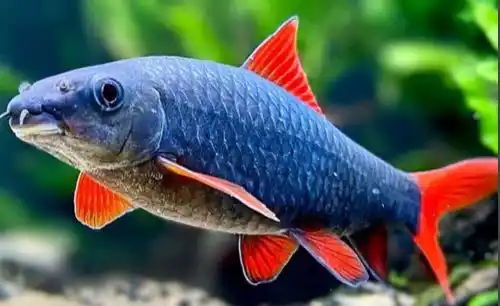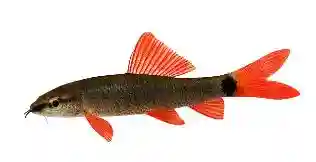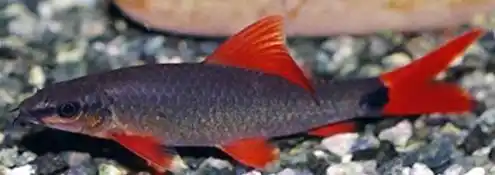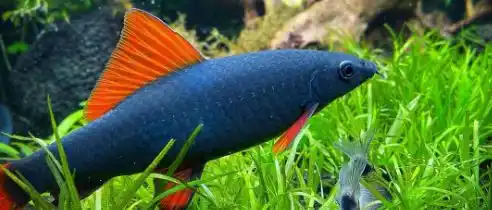Rainbow Sharks, scientifically known as ‘Epalzeorhynchos frenatum’. They are vibrant and energetic freshwater fish that are popular among aquarium enthusiasts. They come from Southeast Asia and stand out because they look awesome and act in special ways.
Rainbow Sharks Physical Characteristics

Rainbow sharks boast a distinct appearance with their sleek, elongated bodies that shimmer with shades of deep red and black. Their fins are beautifully accented with contrasting colors, resembling the rainbow after which they are named. Let’s delve deeper into their physical attributes:
| Characteristic | Description |
|---|---|
| Body Shape | Rainbow sharks feature a streamlined body with a slightly arched back, allowing them to swiftly navigate through water. |
| Dorsal Fin | The dorsal fin stands tall and rigid, showcasing a striking red hue that complements the overall coloration. |
| Caudal Fin | The caudal fin, or tail fin, is forked and exhibits a bold black color, adding to the fish’s visual appeal. |
| Anal Fin | Positioned beneath the body, the anal fin mirrors the caudal fin’s design, contributing to the fish’s balanced look. |
| Pectoral and Pelvic Fins | These fins are translucent and fan-like, providing precise control during navigation and graceful movement. |
| Barbels | Rainbow sharks possess two pairs of sensory barbels around their mouths, which aid in locating food and objects. |
| Color Variation | While the dominant colors are red and black, individual Rainbow Sharks may exhibit subtle variations in hue. |
Rainbow Shark Size

Rainbow Sharks are just the right size for medium to large aquariums. Usually, they grow to about 6 inches long if they live in a tank that’s well looked after and big enough. Their size can change depending on things like their genes, what they eat, and how good their home is.
When Rainbow Sharks become adults, their bright colors and cool patterns stand out even more, making your tank look even prettier. Giving them enough room and taking good care of them helps them grow up healthy and awesome.
Natural Habitat and Behavior of Rainbow Shark
Out in nature, Rainbow Sharks hang out in rivers and streams where the water moves kind of fast. They’re territorial and like to claim their own spot around rocks and plants. To make them feel at home in your tank, give them lots of places to hide and cool things to explore, just like they’d have in the wild.
Creating the Ideal Rainbow Shark Aquarium

Creating a suitable environment is vital for the well-being of your Rainbow Sharks. Opt for an aquarium of at least 50 gallons to accommodate their active nature. Include smooth rocks, caves, and driftwood to replicate their native habitat. A sandy substrate will prevent damage to their barbels while exploring. Here are the ideal water parameters for Rainbow Shark:
- Temperature: Keep the water temperature within the range of 74°F to 79°F (23°C to 26°C) to ensure their metabolic processes function optimally.
- pH Level: Maintain a slightly acidic to neutral pH level between 6.5 and 7.5. Fluctuations outside this range can lead to stress and health issues.
- Water Hardness: Aim for moderate water hardness levels, with a dGH (general hardness) of 5-15 and a dKH (carbonate hardness) of 3-10.
- Ammonia and Nitrite: Keep ammonia and nitrite levels at zero to prevent toxicity and stress. Regular water testing and proper filtration are essential.
- Nitrate Levels: Maintain nitrate levels below 20 ppm through regular water changes. Elevated nitrate levels can lead to health problems.
Exploring the Waters of Southeast Asia
Beyond the aquarium glass, a cultural odyssey awaits. Rainbow Sharks have been revered in Southeast Asian countries, and woven into local myths and traditions. In Thailand, they are celebrated as symbols of prosperity and luck. This cultural connection adds depth to the care and appreciation of these fish, enriching the journey for enthusiasts worldwide.
Water Care Tips for Rainbow Sharks
Maintaining optimal water conditions is essential. Keep the temperature between 74°F to 79°F (23°C to 26°C) and maintain a slightly acidic to neutral pH level of 6.5 to 7.5. Perform regular water changes and invest in a quality filtration system to keep the water clean and clear.
Rainbow Shark Feeding and Nutrition

Rainbow Sharks eat a bit of everything—they’re omnivores and they love their food! Give them a mix of good-quality pellets and flakes, and sometimes treat them with live or frozen snacks like bloodworms and brine shrimp. Feed them small amounts a few times a day to make sure they get all the nutrients they need.
Managing Health and Diseases in Rainbow Sharks
To keep your Rainbow Shark healthy, monitor their behavior and appearance regularly. Look out for signs of illness such as lethargy, loss of appetite, or unusual spots on their bodies. Quarantine new fish before introducing them to the main tank to prevent potential diseases.
Rainbow Sharks Breeding and Reproduction
Breeding Rainbow Sharks (Epalzeorhynchos frenatum) in a home aquarium can be challenging due to their territorial nature. However, if you’re up for the task, provide a separate breeding tank with appropriate hiding spots. Once successful, the female will lay adhesive eggs on surfaces, and diligent care is needed for the fry’s survival. Here’s a detailed overview of their breeding and reproduction processes.
- Maturing for mating:
- Rainbow sharks typically reach sexual maturity around 1 to 2 years of age.
- You can tell males and females apart by noticing subtle variations in their body shape and fin structure.
- Creating the Right Environment:
- To help Rainbow Sharks get in the mood for breeding, set up a tidy tank with spots to hide, smooth rocks, and lots of plants.
- Keep the water just right—around 77–80°F (25–27°C)—and make sure the pH levels stay steady. That’ll give them the best chance for breeding.
- Courtship Rituals:
- Breeding usually starts with courtship rituals. The male shows off his bright colors and does chase-like moves to catch the female’s eye.
- Egg Laying and Fertilization:
- Once courtship is successful, the female lays eggs on surfaces like rocks or plants.
- The male fertilizes the eggs, and both parents play a role in protecting the eggs from potential threats.
- Egg Incubation:
- Rainbow Shark eggs typically hatch within 2 to 4 days, depending on water temperature.
- During this period, parents guard the nest and ensure water circulation around the eggs.
- Caring for Fry:
- After hatching, the fry (baby fish) remains attached to the egg sac for a short period, absorbing nutrients.
- Once free-swimming, the fry can be fed infusoria or commercially available liquid fry food.
- Adequate hiding spots are crucial to protect fry from potential predators, including their own parents.
- Growing Fry to Juveniles:
- As the fry grows, gradually introduce finely crushed flake food and small live or frozen foods.
- Frequent water changes and monitoring water parameters are essential to ensure the health and growth of the fry.
- Separating Juveniles:
- When the young Rainbow Sharks are big enough to take care of themselves, it might be a good idea to move them to their own tank. This helps avoid fights among the grown-ups and keeps things calm.
- Observing Natural Behavior:
- Breeding Rainbow Sharks can provide fascinating insights into their natural behaviors and instincts.
- Be prepared for challenges, including potential aggression or unsuccessful breeding attempts.
- Seeking Expert Advice: Seek guidance from experienced aquarists or breeders who have successfully bred Rainbow Sharks, if you’re new to breeding freshwater fish.
Breeding Rainbow-Sharks requires dedication, patience, and a thorough understanding of their behaviors.
Rainbow Sharks Compatibility with Other Fish

Ensuring the harmonious coexistence of Rainbow Shark with other fish species in your aquarium is essential for maintaining a peaceful and thriving aquatic environment. Here are some valuable insights into their compatibility:
- Peaceful Mid-Level Swimmers: Rainbow Sharks are best suited to live with peaceful mid-level swimmers, such as:
- Avoid aggressive or bottom-dwelling fish: To prevent conflicts, it’s recommended to avoid housing Rainbow Shark with:
- Aggressive Cichlids
- Bottom-Dwelling Catfish
- Territorial Behavior: Rainbow sharks can get pretty territorial, especially if other fish invade their space. Giving them lots of hiding spots and separate areas can help calm down any aggression.
- Tank Size Consideration: Make sure your tank is big enough for Rainbow Sharks and their pals. A roomy tank means less stress and fewer fights over territory.
Choose tank buddies carefully and make a cozy home where everyone gets along. That way, your rainbow shark and other fish can live happily and safely together.
Conclusion
Rainbow sharks are beautiful and active fish that can thrive in a well-maintained aquarium. By following our guide, you’ll be well-equipped to provide these unique creatures with a happy and healthy home.
Frequently Asked Questions (FAQs)
Are rainbow sharks suitable for beginners?
Yes, with proper research and care, beginners can enjoy keeping rainbow sharks. Their unique appearance and behavior make them an exciting addition to any aquarium.
Can rainbow sharks coexist with other shark species?
It’s not recommended to keep rainbow sharks with other shark species, as they can become territorial and aggressive toward each other.
Do rainbow sharks require special lighting?
While they don’t require specialized lighting, providing a natural day-night cycle enhances their well-being.
How can I differentiate between male and female rainbow sharks?
Males are generally smaller and slimmer than females. During breeding, females may appear rounder due to the eggs they carry.
How big will a rainbow shark get?
Rainbow sharks can grow up to around 6 inches in length.
Do rainbow sharks clean the tank?
While rainbow sharks may nibble on algae, they are not efficient tank cleaners and should not be solely relied upon for cleaning.
Are rainbow sharks peaceful?
Rainbow sharks can get territorial and might not be so friendly, especially to fish that look alike or hang out at the bottom of the tank.
Are rainbow sharks aggressive?
Rainbow sharks can display aggression, especially when establishing territory or during mating. Careful tankmate selection and providing hiding spots can help manage this behavior.
Sources and References
“Rainbow Shark Care Guide & Species Profile” – (Fishkeeping World)
Disclaimer
“As an Amazon Associate, we earn from qualifying purchases where there is no additional cost to you. This is one way to support us.” The products displayed here are well-researched, highly rated by users, and fast-moving.






